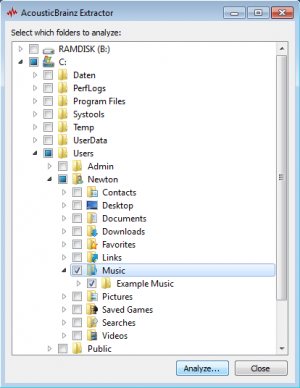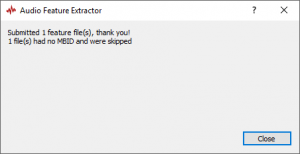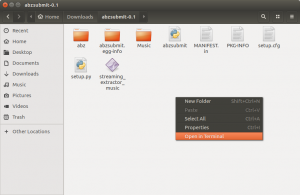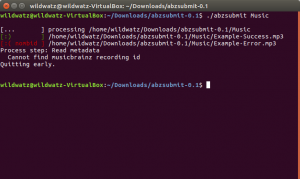How to Submit Analyses to AcousticBrainz: Difference between revisions
No edit summary |
No edit summary |
||
| Line 1: | Line 1: | ||
When adding a release or a single recording to MusicBrainz, |
When adding a [[Release|release]] or a single [[Recording|recording]] to MusicBrainz, you should also submit AcousticBrainz analyzes for all of the added material too. These analyzes describe the acoustic characteristics of the music, including low-level spectral information and information for genres, moods, keys, scales and much more. For more information about AcousticBrainz, look [http://acousticbrainz.org here]. |
||
The process of analyzing music files (and submitting these analyzes to AcousticBrainz) is luckily full-automatic, so you just have to do the setup. |
The process of analyzing music files (and submitting these analyzes to AcousticBrainz) is luckily full-automatic, so you just have to do the setup. |
||
| Line 9: | Line 9: | ||
* A working AcousticBrainz client, downloadable at the [https://acousticbrainz.org/download AcousticBrainz website] - at this time, only Windows, OSX and Linux are supported |
* A working AcousticBrainz client, downloadable at the [https://acousticbrainz.org/download AcousticBrainz website] - at this time, only Windows, OSX and Linux are supported |
||
* The music files ( |
* The music files (if available use lossless files, otherwise lossy files will do it too), which have to be properly tagged with [[MusicBrainz_Identifier| MBIDs]] - if you don't know how to do this, read the [https://picard.musicbrainz.org/docs/guide Picard tutorial] |
||
It is recommended to put all the files in one folder, no matter if they are from different releases |
It is recommended to put all the files in one folder, no matter if they are from different releases, because all files can then be analyzed at once and don't have to be analyzed seperately (For Windows this is even necessary, you can only choose folders to analyze there). |
||
== Analyzing files == |
== Analyzing files == |
||
| Line 30: | Line 30: | ||
:{{note}} This may take a while, so make sure to have a stable internet connection and preferably don't do anything else during this time on your computer. |
:{{note}} This may take a while, so make sure to have a stable internet connection and preferably don't do anything else during this time on your computer. |
||
As you can see, properly tagged files will be submitted, files without MBIDs will be skipped, so make sure to have the files properly tagged. Additionally, all previously analyzed files won't be analyzed a second time (when clicking analyze again); the |
As you can see, properly tagged files will be submitted, files without MBIDs will be skipped, so make sure to have the files properly tagged. Additionally, all previously analyzed files won't be analyzed a second time (when clicking analyze again); the program will output, that there are no audio files in the selected folder (although there are, but have already been analyzed). |
||
=== Linux === |
=== Linux === |
||
| Line 44: | Line 44: | ||
As you can see, properly tagged files will be submitted, files without MBIDs will be skipped, so make sure to have the files properly tagged. Additionally, all previously analyzed files won't be analyzed a second time (when trying to analyze again); the |
As you can see, properly tagged files will be submitted, files without MBIDs will be skipped, so make sure to have the files properly tagged. Additionally, all previously analyzed files won't be analyzed a second time (when trying to analyze again); the program will directly show ":) done". |
||
== Have a look at your |
== Have a look at your submissions == |
||
After having analyzed and submitted the files, you can see them at: |
After having analyzed and submitted the files, you can see them at: |
||
| Line 52: | Line 52: | ||
*acousticbrainz.org/api/v1/<MBID>/high-level |
*acousticbrainz.org/api/v1/<MBID>/high-level |
||
*acousticbrainz.org/api/v1/<MBID>/low-level |
*acousticbrainz.org/api/v1/<MBID>/low-level |
||
Or for or a more general overview: |
|||
*acousticbrainz.org/<MBID> |
|||
You just have to replace <MBID> with the related MBID of the recording you just submitted. This ID you have to look up manually, for example on [https://musicbrainz.org MusicBrainz] as part of the recordings' URL or at the recordings' details. |
You just have to replace <MBID> with the related MBID of the recording you just submitted. This ID you have to look up manually, for example on [https://musicbrainz.org MusicBrainz] as part of the recordings' URL or at the recordings' details. |
||
Revision as of 19:51, 4 January 2017
When adding a release or a single recording to MusicBrainz, you should also submit AcousticBrainz analyzes for all of the added material too. These analyzes describe the acoustic characteristics of the music, including low-level spectral information and information for genres, moods, keys, scales and much more. For more information about AcousticBrainz, look here.
The process of analyzing music files (and submitting these analyzes to AcousticBrainz) is luckily full-automatic, so you just have to do the setup.
Prerequisites
To analyze one or more recordings (for example as part of a whole release) you need to have the following:
- A working AcousticBrainz client, downloadable at the AcousticBrainz website - at this time, only Windows, OSX and Linux are supported
- The music files (if available use lossless files, otherwise lossy files will do it too), which have to be properly tagged with MBIDs - if you don't know how to do this, read the Picard tutorial
It is recommended to put all the files in one folder, no matter if they are from different releases, because all files can then be analyzed at once and don't have to be analyzed seperately (For Windows this is even necessary, you can only choose folders to analyze there).
Analyzing files
After extracting the downloaded packages, they are ready to use.
Windows
Open acousticbrainz-gui.exe and select the folder with the files and click "Analyze...".
Now wait until the process is finished:
 Note: This may take a while, so make sure to have a stable internet connection and preferably don't do anything else during this time on your computer.
Note: This may take a while, so make sure to have a stable internet connection and preferably don't do anything else during this time on your computer.
As you can see, properly tagged files will be submitted, files without MBIDs will be skipped, so make sure to have the files properly tagged. Additionally, all previously analyzed files won't be analyzed a second time (when clicking analyze again); the program will output, that there are no audio files in the selected folder (although there are, but have already been analyzed).
Linux
Open the extracted folder and open the terminal from this folder. Enter the command: ./abzsubmit [directory] to analyze all files at the given directory. This will be a single file or all files in a folder if the directory points to a folder. In this example, the files are in the "Music" folder which is located directly in the folder from where the terminal has to be opened:
Wait until the process is finished.
As you can see, properly tagged files will be submitted, files without MBIDs will be skipped, so make sure to have the files properly tagged. Additionally, all previously analyzed files won't be analyzed a second time (when trying to analyze again); the program will directly show ":) done".
Have a look at your submissions
After having analyzed and submitted the files, you can see them at:
- acousticbrainz.org/api/v1/<MBID>/high-level
- acousticbrainz.org/api/v1/<MBID>/low-level
Or for or a more general overview:
- acousticbrainz.org/<MBID>
You just have to replace <MBID> with the related MBID of the recording you just submitted. This ID you have to look up manually, for example on MusicBrainz as part of the recordings' URL or at the recordings' details.
| How-To Pages | |
|---|---|
| Introductory Guides | Beginners' Guide · Creating an Account · Editing · Voting · Writing Edit Notes |
| Basic How-Tos | Adding an Artist · Adding Relationships · Using the Relationship Editor · Using Artist Credits · Adding a Release · Works · Events · Places · Series · Instruments · Areas |
| Specific How-Tos | Merging Releases · Merging Recordings · Removing Entities · Adding Cover Art · Identifying Labels · Splitting Artists · Adding Standalone Recordings · Adding Disc IDs · Cancelling Edits · Searching for Edits · Reporting a User · Reporting an Issue · Working with AcoustIDs · Tagging Files with Picard |



